Deux portraits à Claudia 26/05/2014
Deux portraits à Claudia 26/05/2014
二〇十四年 五月 二十六日 羞龍 八大山人
Deux portraits à Claudia 26/05/2014
二〇十四年 五月 二十六日 羞龍 八大山人
Alcune copie dei Carnet che ho riprodotto ed autoedito in occasione dell’ultimo Rendez-vous di Clermont-ferrand sono disponibili. Tutti i Carnet contengono un libretto interno rimovibile con le trascrizioni dei testi dei taccuini. I carnet giapponesi (Lisboa em Azulejos, The Drifter) sono rilegati a mano su copertina rigida in similpelle o stoffa. Anche la piegatura delle pagine degli album giapponesi (a fisarmonica) e l’incollaggio delle varie parti è fatto a mano.
L’edizione, autoprodotta e realizzata, è limitata, numerata e personalizzata.
Carnet di viaggio sul Portogallo (Cascais, Praia do Guincho, Lagos, Sagres), riproduzione del taccuino originale su Moleskine album acquerello, copertina morbida, brossura. Libretto interno removibile con la trascrizione dei testi. Pagina dedicata (in Inglese) https://www.xiulong.it/Xiuart/?p=1697
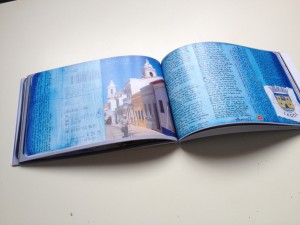
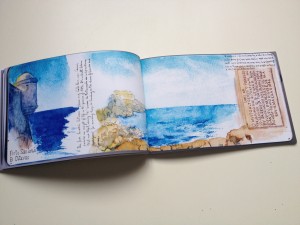
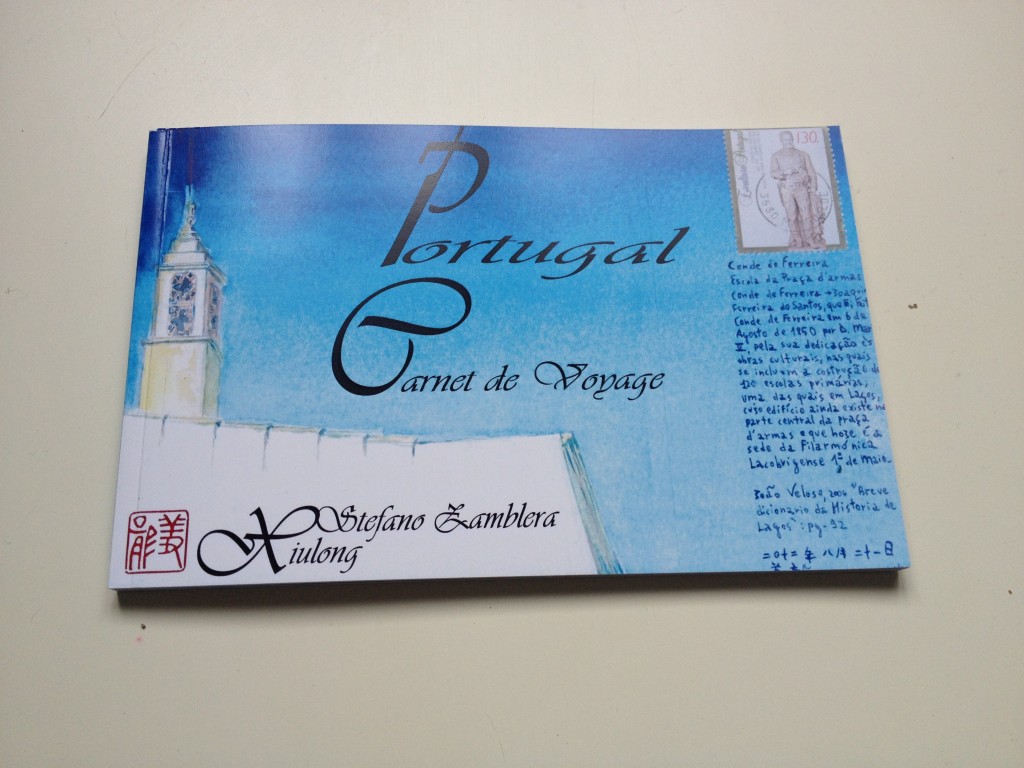
| Portugal – Carnet de Voyage |
![]()
*********
Riproduzione del primo dei due taccuini giapponesi Moleskine che ho dipinto a Lisbona, in stile “Azulejos”. Copertina rigida in finta pelle blu fatta a mano, rilegatura e piegatura delle pagine “a fisarmonica” a mano, libretto interno rimovibile con la trascrizione dei testi. Pagina dedicata (in Inglese) https://www.xiulong.it/Xiuart/?p=1697
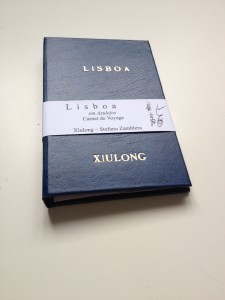
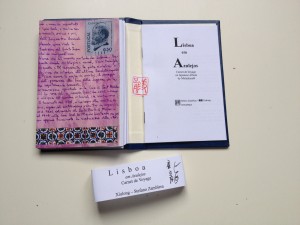
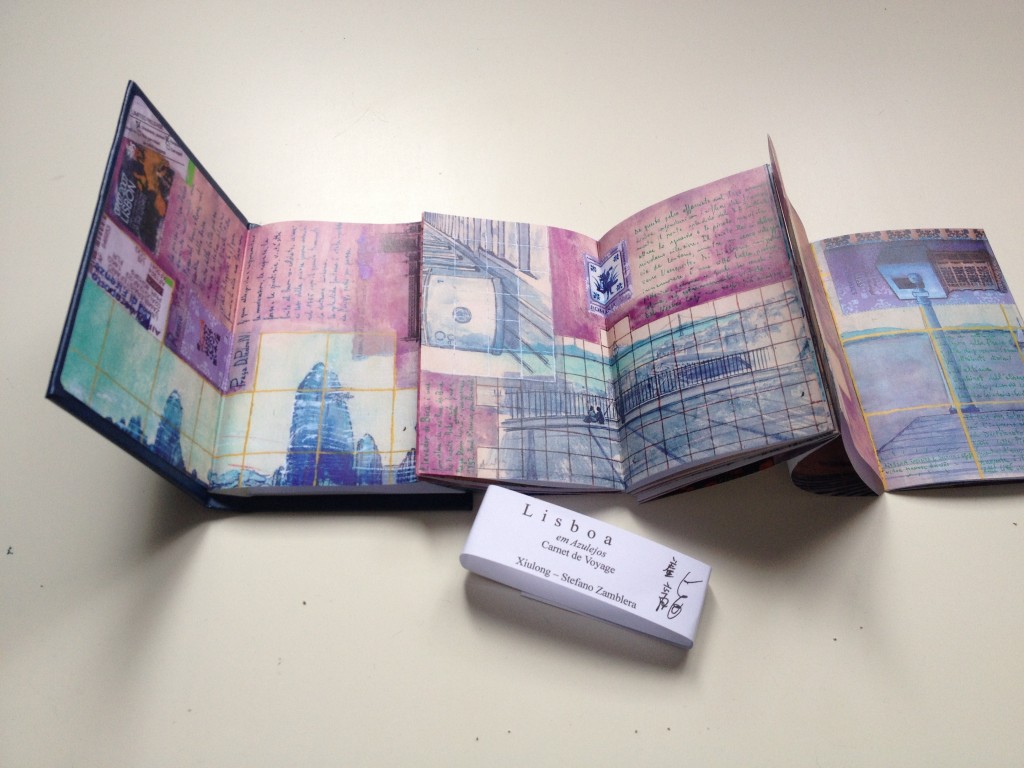
********
The Drifter – taccuino giapponese, copertina rigida in tela, piegatura e rilegatura “a fisarmonica” fatta a mano. Libretto interno rimovibile con la trascrizione dei testi. Pagina dedicata (in Inglese) https://www.xiulong.it/Xiuart/?p=1792




Alcune copie dei Carnet che ho riprodotto ed autoedito in occasione dell’ultimo Rendez-vous di Clermont-ferrand sono disponibili. Tutti i Carnet contengono un libretto interno rimovibile con le trascrizioni dei testi dei taccuini. I carnet giapponesi (Lisboa em Azulejos, The Drifter) sono rilegati a mano su copertina rigida in similpelle o stoffa. Anche la piegatura delle pagine degli album giapponesi (a fisarmonica) e l’incollaggio delle varie parti è fatto a mano.
L’edizione, autoprodotta e realizzata, è limitata, numerata e personalizzata.
Carnet di viaggio sul Portogallo (Cascais, Praia do Guincho, Lagos, Sagres), riproduzione del taccuino originale su Moleskine album acquerello, copertina morbida, brossura. Libretto interno removibile con la trascrizione dei testi. Pagina dedicata (in Inglese) https://www.xiulong.it/Xiuart/?p=1697
| Portugal – Carnet de Voyage |
![]()
*********
Riproduzione del primo dei due taccuini giapponesi Moleskine che ho dipinto a Lisbona, in stile “Azulejos”. Copertina rigida in finta pelle blu fatta a mano, rilegatura e piegatura delle pagine “a fisarmonica” a mano, libretto interno rimovibile con la trascrizione dei testi. Pagina dedicata (in Inglese) https://www.xiulong.it/Xiuart/?p=1697
********
The Drifter – taccuino giapponese, copertina rigida in tela, piegatura e rilegatura “a fisarmonica” fatta a mano. Libretto interno rimovibile con la trascrizione dei testi. Pagina dedicata (in Inglese) https://www.xiulong.it/Xiuart/?p=1792

The Drifter – taccuino giapponese. Il libretto removibile con la trascrizione dei testi del taccuino
An experimental Carnet, painted on a Japanese Album consecrated and birth from “The Drifter” surf movie, a biographical account and documentary by Taylor Steele about Rob Machado drifting alone, surfing in Bali and Indonesia.
This Carnet was hosted at the 2014 Rendez-vous du Carnet de Voyage in Clermont-Ferrand. Enjoy the clip for presentation and download the preview as .pdf: The Drifter – Carnet, Japanese Album by Moleskine (original Carnet)
This is a very special carnet, as although its classical “appearance” in style: a Japanese Album by Moleskine® mostly painted by watercolors, written with inks and patched with some stamps and paper-cuts, it is definitively an experimental work
At first in this Japanese album I’m not conventional at all because it isn’t related to any physical travel I did in Bali and Indo, but this it is a carnet I made from a surf movie by Taylor Steele, a documentary consecrated to a particular moment of the life of the actually free-surfer Rob Machado during its wanderings into Bali and Indo.
In other words I reversed in this carnet, the voyage sprung-out in me by seeing this movie, which to me isn’t just a movie, as I lived it as the making-in-images and a visual narration of a series of experiences and feelings that I found in voyaging and that I share with the starring.
Thus, I felt there’s a lot of paths, coincidences (do the coincidences really exist?) and invisible strings which deeply linked me to Machado and Steel as respectively the traveler and the teller, a sort of convergence of numerous paths which permeate this movie of some indescribable richness that, as other “normal” voyages, I shall reverse in a carnet.
I moreover feel that this surf-movie is in truth a Carnet de Voyage which Steel and Machado made together, fulling it with all the stuff I use to look for and “squeeze” in my carnets: at first the astonishment in front of the astounding beauty of splendid Bali and Indonesia, but not idyllic, where I’ve always wished to have been and where I’m sure I’ll go sooner or later.
Steele – Machado documentary I felt thus to be a carnet, telling about a travel which isn’t made, view and narrated with the eyes and the lens of the “tourist”, but I feel they’re the ones of the traveler in-love with the see, the surfer who’s looking for waves, absorbed into the ocean and fulfilled in surfing.
Surfing could be seen as an extreme sport, may challenging against the most powerful elements of nature. But it also may could seen and lived as the never-ending research, research of perfect wave, also research of complete loneliness with our self, practice of balance and equilibrium, the art of drawing white serpentine into the tube of a green wave spiraling on a turquoise sheet of crystal, in a Zen – paint lasting as a skimming of the wave.
Surfing. Painting.
Practicing Taijiquan or more in general Wushu…
Arts.
I can’t never realize if such vision of life I have is the driving force that push me to look for and practice arts like painting, Wushu or surfing, or if it is indeed the practice of arts which make me gain a life made by completely different activities and permeated of signifies…; maybe both, as both are reasons which pushed me being so captured by this movie to spill it out on a Japanese carnet.
Anyhow both in surfing and in this “Carnet de Voyage” made movie by Taylor Steele and Rob Machado, I can live sensations and visions which I deeply feel as mine, which belong to such precious moments within I remain in absolute loneliness and osmosis with the Creation, as when I paint, as when I’m sitting on my board near a reef-break just outside Waikiki, while I’m moving not-moving (how is natural, sometimes, in surfing and painting the accomplishment of Taoist principle of 無爲 wu wei – non action), as in the total lapsing into a Chen Taiji routine.
Those consist also in “a drifting”.
Pushed by absolute love and amazement for nature, its manifestations and forces, trying to feel and indulge them. As when painting, with total abandon and assimilation with the subject.
A sort of alchemy process which I think in me actualizes with the solicitation of some perceptive expressive and synaptic capacities.
As any other travel I made and paint on my carnets, the travel made by Machado and Steel aroused in me the accomplishment of a deep an long inner journey (another set of opera by Taylor Steele is indeed called “Innersection”…), an introspection induced by the physical traveling of these human beings to which, somehow and for some reason, I feel linked.
Physical traveling and inner journey is moreover well presented by the strong introspection of Machado, as this journey to Bali and Indo is not the typical prototype of the surf-trip, but is a “drifting”, a drifting alone.
Again, the movie is thus a documentary which lies outside of the classical cliche of a surf-movie with fast and powerful music and rapid succession of surf scenes with changing of the best world surfers, making the most fearless and extreme tricks riding powerful wave-monsters.
Music of the “drifting alone” of Machado is slow.
Surf-scenarios of cadence rhythm with never-ending tubes and serpentine painted into the most beautiful glassy waves I’ve never seen in my whole life, interchange with sudden and amazing flashes of Indonesian and Balinese life.
The words of Machado, presented as thoughts he silently spoke to himself, touch some arguments which are so dear to me as a surfer and a painter of carnet, as the capacity of stopping for a moment and meditate:
“I was on the road doin’ the World then 10 years
Spain, France, Australia, Brazil
That’s all have created a comfort zone
back bringing home with me
Staying in the same Hotels, eating in the same restaurants
Surfin’ in the same spots.
Sometimes I feel like I wasn’t almost travelin’ at all
and that’s why I’m here
To break out all this comfort zone
To truly leave home behind
Just takin’ day by day”
In other words, what do I mean as traveling for real.
You may wish to have a copy of “The Drifter – Carnet on Japanese Ablum”, a handmade Japanese-accordion folded and hardcover Carnet.

The Drifter – Carnet, Japanese Album. Removable booklet with transcription of text (English and Italian version)
**********
Or if You just like how I work, may You pay me a coffee (€ 1,00)
Anyhow, thanks for visiting and reading ’till the end!
Click here for a free preview of the Carnet as an eBook!
This Carnet de Voyage painted on Watercolor Album by Moleskine® is consacrated to Portugal, and belongs to a set of carnets I’ve painted there in the summer of 2012 by traveling from Lisboa to Cascais and Guincho, then descending by bus in the south, in Algarve, to Lagos and Sagres, and finally back to Lisboa.
Click here for a preview (or download) of the Japanese Album as a pdf!
I was so impressed from Azulejos art, and among all azulejos, the sight of the “Gran Visión de Lisboa”, a huge “mural azulejado” in which it is represented the life of the city before the terrible earthquake of 1755 renforced in me both idea and inspiration to paint about Lisboa in “azulejos style”. That’s what I did by fulling 2 Japanese Album by Moleskine ®, while I prefer to paint on Watercolor Album and flying sheets about the other places we’ve been.
Choice of “Azulejos style ” is not but another expression of one of my idea about a possible approach to voyaging, and at the same time a possible way of making Carnet de Voyage.
In the optical of a different approach to traveling, as for painting Carnet de Voyage, the study of local culture, artistic expression, language and history are paths which permit to start traveling into strange lands and let me escape from boundaries of the “different”: the latter start just outside myslef and my daily abitudes.
Thanks to such approach I thus just can start travel times and times before phisically getting into voyage…; there are plenty of travels I’m sure I begun from very old time! Some of them since I have a memory, others I’m sure I’ll discover sooner or later.
Moreover, once I’m traveling, a minimal knowledge of local language, history and culutre I feel to me as the more comfortable and the best form I may use to approach with a different way of traveling, a point of view which differs from the “normal” one of the tourist cliché.
I love going somehow little deeper into different cultures, evenif I’m sure I’m just tasting little parts of a whole that requires other timing and focusing.
It is in this optical that the study of “a lingua portuguesa” has been the main activity I have made for the best part of 2012, study that took me very quickly in the lucky meet with Pessoa, Camoes and the Fado of Cristina Branco and Amalia Rodrigues.
About Camoes, it happened that some passages I naturally recalled to memory while walking into Lisboa, thus quote and put them into “Lisboa em Azulejos” Japanese Carnets.
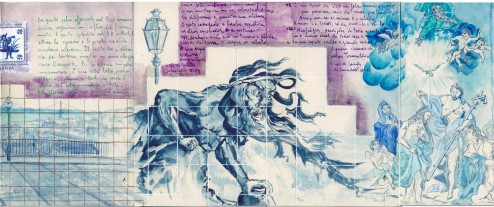
Adamastor, Miradouro and Igreia de Sao Roque fresco with Camoes, from Lisboa em Azulejos Carnet de Voyage, Japanese Moleskine
Pessoa deeply hit me and impressed me so much with his caleidoscopic poetry. Often happened that the visions I attended in Portual I often lived and expressed like the materialization of some of Pessoa verses, especially in front of lighthouses and other suggestive landscapes.
Such deep empathy with Pessoa is probably dued also by knowing his biography and dualistic life of comptabilist for profession and poet as a man, condition which I deeply feel to be also mine, and which immediately linked me deeply to the poet, and gives me others keys of reading his verses.
All these ideas thus materialized into these carnets also by using – with all my limits, imprecisions and mistakes – “a lingua portuguesa” and English respectively as the main and second language, with a drastic reduction of the use of my mothertongue.
It was not but a natural expressions and process, very similar to the one which tooks me to paint Lisboa in an azulejos reinterpretation.
Both are natural expression of my feelings and thoughts coming directly from my heart in front of the beauty of Portugal, a very different thing from a process of translation from a language (media) to another.
Other times, using of not Italian language could be simply the transcription of original sources and available documentations.
You may wish to have a reproduction of my Carnet of Portugal?
*********
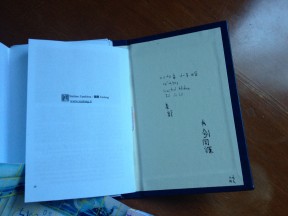
Lisboa em Azulejos. Limited, numbered and personalized edition. Removable booklet inside with transcription of texts.
*********
Or if You just like how I work, may You pay me a coffee (€ 1,00)
Anyhow, thanks for visiting and reading ’till the end!
Deux portraits à Claudia 22/04/, 02/05/2014
二〇十四年 四月 二十二日 羞龍
二〇十四年 五月 二日 羞龍
Deux portraits à Claudia 09, 17/04/2014
二〇十四年 四月 九日 羞龍
二〇十四年 四月 十七日 羞龍 八大山人
Deux portraits à Claudia 02, 03/04/2014
二〇十四年 四月 二日 羞龍
二〇十四年 四月 三日 羞龍 八大山人
Deux portraits à Claudia 02, 03/04/2014
二〇十四年 四月 二日 羞龍
二〇十四年 四月 三日 羞龍 八大山人
Negli ultimi 2 incontri di Domenica 23 e 30 Marzo abbiamo sia visto tutta la forma di 13 movimenti secondo il maestro Zhu Tiancai, sia parlato di argomenti interessanti che sono stati spunto di alcune riflessioni personali.
La riflessione più importante verte su una possibile (e opinabile) distinzione di 2 livelli o modalità di pratica del Wushu, ossia:
Non penso che l’una escluda l’altra. Tuttavia per allenarmi nell’apprendimento e migliorare, ad esempio, i contenuti tecnici che lo stile esprime attraverso le forme codificate, mi torna bene adottare delle giochesse che mi permettono di finalizzare meglio il lavoro. Soprattutto in un contesto dove il “tempo libero” che posso dedicare al Wushu, purtroppo, non è molto e tende a diminuire.
Sempre parlando per esperienza personale, e quindi tutto da prendere con le pinze, posso citare ad esempio come sia impostata nel parco di Tiantan di Pechino, la lezione “tipo” quotidiana:
Questa esperienza di Tiantan è perfettamente coerente a quanto ho vissuto all’Istituto di Wushu grazie al Maestro Giuseppe : l’allenamento dei gruppi di movimenti consentiva prima l’apprendimento delle sequenze di tecniche, e poi – o meglio dire durante – un labor limae sulle medesime sezioni dal punto di vista tecnico, espressivo, ritmo, etc…
Quindi secondo me il nocciolo del discorso dell’allenamento volto al miglioramento è proprio l’allenamento delle sequenze brevi di movimenti concatenati.
Usando la terminologia del Wushu, questa unità “base” (ma mica tanto base poi…) dell’allenamento, costituita da una breve sequenza di movimenti concatenati si dice 组合动作 Zuhe Dongzuo – gruppo di movimenti.
Applicando questo pensiero alla forma di 13 movimenti di pugno Chen del maestro Zhu Tiancai, ho allora estratto quattro 组合动作 Zuhe Dongzuo che prenderei e prendo come unità di base da allenare e ripetere numerose volte per l’apprendimento e l’assimilazione dei contenuti.
Questo approccio è del tutto personale ed arbitrario. Frutto dei semi lasciati da pochi e validi insegnanti, di cui cerco di percorrere strade ed orme con tutti i miei limiti. In questo contesto – limiti ed interpretazione personale – si inserisce anche la divisione dei quattro 组合动作 Zuhe Dongzuo, una segmentazione arbitraria e personale, eseguita sia sulla memoria degli allenamenti alla Laojia Yilu con Alessio Frosali e con il Maestro Fabio (serpentebianco.org) sia su quei segmenti che ad oggi ritengo ottimali per l’allenamento volto ad un miglioramento.
Di seguito i quattro 组合 Zuhe tratti da un filmato della 13 di pugno eseguita da Zhu Tiancai; infine l’intera forma, sempre eseguita dal maestro Zhu, 2 volte di seguito.
5 Movimenti, da posizione neutra.
4 Movimenti, da 單鞭 Dan bian – la frusta:
3 Movimenti, da 白鶴亮翅 Baihe Liangchi – la gru bianca spiega le ali:
3 Movimenti, da 掩手肱拳 Yan shou hong quan – coprir la mano e colpire col pugno:
La forma 13 movimenti eseguita 2 volte di seguito da Zhu Tiancai.
I caratteri sono in cinese tradizionale. Ho estrapolato dai 13 movimenti i gesti di apertura e di chiusura del Taiji, inserendo al 1° e 13° movimento 金剛搗碓 Jingang dao dui – il Jingang pesta nel mortaio.
太極初勢 Taiji chushi – gesto iniziale del Taiji
太極收勢 Taiji shushi – gesto di chiusura del Taiji
Materiale di riferimento per entrambe le clips:
二〇十四年 四月 一日
羞龍 Xiulong